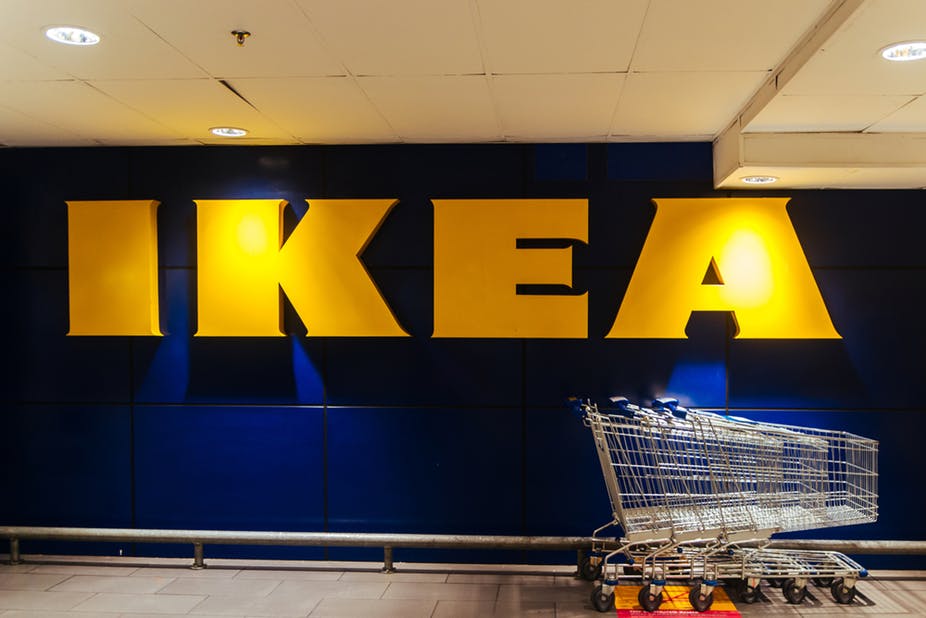For decades, IKEA has filled homes across the world with bookcases, beds, cardboard boxes and countless tea lights. The company’s business model, based on huge production runs of identical stock, allowed it to export Scandinavian style at an affordable price.
Its products are so popular and so ubiquitous, that you might find yourself in a friend’s home sitting on a sofa that is very similar to your own, looking at a bookcase that matches yours and eating with very familiar looking cutlery. IKEA created a reasonably priced way for customers to express themselves at home, and while it may also have helped build a world of indentikit interiors, it opened consumers to what was otherwise expensive design.
As a product design specialist I applaud IKEA for how they have developed their business and invested in design to bring great products to the masses, including the use of materials to drive down prices – look inside one of their coffee tables and you’ll find a hollow core supported with card.
IKEA’s trades on the idea of family connections and aims for an emotional connection with customers. Instead of relying on numbers, for example, products are named after Scandinavian islands, names of people, birds and berries.
They continue to innovate in materials and production techniques which drive prices lower and lower. When the first UK store opened in 1987 (the company is celebrating its 30th British birthday) the cost of a loaf of bread was around 40p, and the classic “Lack” coffee table retailed at £18. Today, three decades on, that same table costs £14.
IKEA are widely considered as the “kings of flat pack furniture”, having cleverly exploited the potential of DIY assembly. Being able to visit a store, pick a wardrobe, chuck the cleverly packaged parts into the boot and drive home proved to a very popular approach, avoiding waiting weeks for delivery and simple – even if the accompanying instructions aren’t always as simple as they look. Social media is full of insights about IKEA-instigated arguments over how to construct furniture (or even just trying to navigate the stores’ pathways). But the company remains highly thought of.
Scando-chic
IKEA’s Scandinavian roots and design DNA made it stand out when it arrived in the UK (it was already well established in Germany, France, Japan and Australia). Along with Habitat, IKEA spearheaded a clear departure from chintz and overly decorative furniture and homeware. The new shopping experience of choosing from “rooms” set up with IKEA goods excited customers who came from far and wide to visit the distinctive blue and yellow box-like stores.
IKEA’s range of products has expanded and evolved in the last 30 years but some items like the famous Billy bookcase, continue to sell as they have done for decades. The Billy is a beautifully simple product that can be transformed with hundreds of options, whether you want to change the colours, add doors, or expand the size of your collection.
The popularity of IKEA means so many people have the same furniture, bedding and accessories in their homes. But it also means a lack of individualism in the very places we like to think most reflect our personalities. Nevertheless, some aim to customise: “IKEA hackers” turn colanders into lamps or shelves into headboards, producing unique pieces from mass produced products.
Modern design
IKEA itself has not become lazy or complacent when it comes to design. The PS 2014 pendant lamp, one of their most famous recent additions, is an engineering masterpiece.
Closed, the lamp forms a white sphere with a jigsaw style pattern. But with the simple pull of a string the sphere opens, revealing its interior copper colour and increasing the brightness of the light emitted. It works beautifully and offers a great user experience. It is something to show off, and a real talking point.
Other parts of its range demonstrate great Scandinavian design at a much higher price point.
In my own home, I have a Malm bed, assorted cushions, candles, bedding and cutlery – simple, stylish and good quality. And they didn’t cost the earth. I don’t know anyone who doesn’t own at least one IKEA product. From its humble and fitting beginnings on a kitchen table in Sweden in 1943, IKEA has transformed the modern design world.
 Dan Lewis does not work for, consult, own shares in or receive funding from any company or organisation that would benefit from this article, and has disclosed no relevant affiliations beyond their academic appointment.
Dan Lewis does not work for, consult, own shares in or receive funding from any company or organisation that would benefit from this article, and has disclosed no relevant affiliations beyond their academic appointment.



 Robinhood Expands Sports Event Contracts With Player Performance Wagers
Robinhood Expands Sports Event Contracts With Player Performance Wagers  Global Demand for Yuan Loans and Bonds Surges as China Pushes Currency Internationalization
Global Demand for Yuan Loans and Bonds Surges as China Pushes Currency Internationalization  JPMorgan’s Top Large-Cap Pharma Stocks to Watch in 2026
JPMorgan’s Top Large-Cap Pharma Stocks to Watch in 2026 
































